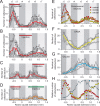Functional organization of vestibular commissural connections in frog
- PMID: 20203191
- PMCID: PMC6634120
- DOI: 10.1523/JNEUROSCI.5318-09.2010
Functional organization of vestibular commissural connections in frog
Abstract
Central vestibular neurons receive substantial inputs from the contralateral labyrinth through inhibitory and excitatory brainstem commissural pathways. The functional organization of these pathways was studied by a multi-methodological approach in isolated frog whole brains. Retrogradely labeled vestibular commissural neurons were primarily located in the superior vestibular nucleus in rhombomeres 2/3 and the medial and descending vestibular nucleus in rhombomeres 5-7. Restricted projections to contralateral vestibular areas, without collaterals to other classical vestibular targets, indicate that vestibular commissural neurons form a feedforward push-pull circuitry. Electrical stimulation of the contralateral coplanar semicircular canal nerve evoked in canal-related second-order vestibular neurons (2 degrees VN) commissural IPSPs (approximately 70%) and EPSPs (approximately 30%) with mainly (approximately 70%) disynaptic onset latencies. The dynamics of commissural responses to electrical pulse trains suggests mediation predominantly by tonic vestibular neurons that activate in all tonic 2 degrees VN large-amplitude IPSPs with a reversal potential of -74 mV. In contrast, phasic 2 degrees VN exhibited either nonreversible, small-amplitude IPSPs (approximately 40%) of likely dendritic origin or large-amplitude commissural EPSPs (approximately 60%). IPSPs with disynaptic onset latencies were exclusively GABAergic (mainly GABA(A) receptor-mediated) but not glycinergic, compatible with the presence of GABA-immunopositive (approximately 20%) and the absence of glycine-immunopositive vestibular commissural neurons. In contrast, IPSPs with longer, oligosynaptic onset latencies were GABAergic and glycinergic, indicating that both pharmacological types of local inhibitory neurons were activated by excitatory commissural fibers. Conservation of major morpho-physiological and pharmacological features of the vestibular commissural pathway suggests that this phylogenetically old circuitry plays an essential role for the processing of bilateral angular head acceleration signals in vertebrates.
Figures










References
-
- Ariel M, Fan TX, Jones MS. Bilateral processing of vestibular responses revealed by injecting lidocaine into the eighth cranial nerve in vitro. Brain Res. 2004;999:106–117. - PubMed
-
- Babalian AL, Vidal PP. Floccular modulation of vestibuloocular pathways and cerebellum-related plasticity: an in vitro whole brain study. J Neurophysiol. 2000;84:2514–2528. - PubMed
-
- Babalian A, Vibert N, Assie G, Serafin M, Mühlethaler M, Vidal PP. Central vestibular networks in the guinea-pig: functional characterization in the isolated whole brain in vitro. Neuroscience. 1997;81:405–426. - PubMed
Publication types
MeSH terms
Substances
LinkOut - more resources
Full Text Sources
